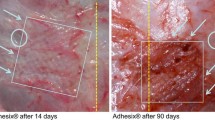Abstract
Background
A prospective animal study involving 12 female swine aimed to measure the strength of tissue attachment to composite mesh at various time points after laparoscopic ventral hernia repair in a porcine model.
Methods
Each animal had two 10 × 16-cm sheets of polypropylene/expanded polytetrafluoroethylene (ePTFE) composite mesh laparoscopically affixed to the abdominal wall with a helical tacking device. No transfascial sutures were used. The animals were euthanized 2, 4, 6, and 12 weeks after surgery, and abdominal walls were resected en bloc with the patches. Each patch was cut into 2 × 7-cm strips, and each strip was independently analyzed. The strength of the tissue attachment to the mesh was measured using a servohydraulic tensile testing frame. The abdominal wall was peeled from the mesh, and the transverse, or “lap-shear” force was recorded. Data are reported as mean force in pounds.
Results
The mean lap-shear force was 0.83 ± 0.06 lbs at 2 weeks, 1.06 ± 0.07 lbs at 4 weeks, 0.88 ± 0.08 lbs at 6 weeks, and 1.13 ± 0.07 lbs at 12 weeks. The mean force was higher at 12 weeks than at 2 weeks (p < 0.05). No other periods were significantly different from any other.
Conclusions
The findings demonstrate that the majority of tissue ingrowth and strength has occurred by 2 weeks after laparoscopic placement of a composite hernia prosthesis. Strength very gradually increases until 12 weeks after surgery. This has clinical implications for human ventral hernia repair. Further study is needed to evaluate the necessity of transfascial sutures for securing polypropylene-based prostheses to the abdominal wall during ventral hernia repair.


Similar content being viewed by others
References
Carbajo MA, Martin del Olmo JC, Blanco JI, de la Cuesta C, Toledano M, Martin F, Vaquero C, Inglada L (1999) Laparoscopic treatment vs open surgery in the solution of major incisional and abdominal wall hernias with mesh. Surg Endosc 13: 250–252
Heniford BT, Park A, Ramshaw BJ, Voeller G (2003) Laparoscopic repair of ventral hernias: nine years’ experience with 850 consecutive hernias. Ann Surg 238: 391–400
Hesselink VJ, Luijendijk RW, de Wilt JH, Heide R, Jeekel J (1993) An evaluation of risk factors in incisional hernia recurrence. Surg Gynecol Obstet 176: 228–234
Holzman MD, Purut CM, Reintgen K, Eubanks S, Pappas TN (1997) Laparoscopic ventral and incisional hernioplasty. Surg Endosc 11: 32–35
Leber GE, Garb JL, Alexander AI, Reed WP (1998) Long-term complications associated with prosthetic repair of incisional hernias. Arch Surg 133: 378–382
LeBlanc KA, Bellanger D, Rhynes KV, Baker DG, Stout RW (2002) Tissue attachment strength of prosthetic meshes used in ventral and incisional hernia repair: a study in the New Zealand white rabbit adhesion model. Surg Endosc 16: 1542–1546
LeBlanc KA, Booth WV (1993) Laparoscopic repair of incisional abdominal hernias using expanded polytetrafluoroethylene: preliminary findings. Surg Laparosc Endosc 3: 39–41
LeBlanc KA, Whitaker JM, Bellanger DE, Rhynes VK (2003) Laparoscopic incisional and ventral hernioplasty: lessons learned from 200 patients. Hernia 7: 118–124
McLanahan D, King LT, Weems C, Novotney M, Gibson K (1997) Retrorectus prosthetic mesh repair of midline abdominal hernia. Am J Surg 173: 445–449
Mudge M, Hughes LE (1985) Incisional hernia: a 10-year prospective study of incidence and attitudes. Br J Surg 72: 70–71
Park A, Birch DW, Lovrics P (1998) Laparoscopic and open incisional hernia repair: a comparison study. Surgery 124: 816–822
Ramshaw BJ, Esartia P, Schwab J, Mason EM, Wilson RA, Duncan TD, Miller J, Lucas GW, Promes J (1999) Comparison of laparoscopic and open ventral herniorrhaphy. Am Surg 65: 827–831
Read RC, Yoder G (1989) Recent trends in the management of incisional herniation. Arch Surg 124: 485–488
Santora TA, Roslyn JJ (1993) Incisional hernia. Surg Clin North Am 73: 557–570
Sitzman JV, McFadden DW (1989) The internal retention repair of massive ventral hernia. Am Surg 55: 719–723
Toy FK, Bailey RW, Carey S, Chappuis CW, Gagner M, Josephs LG, Mangiante EC, Park AE, Pomp A, Smoot RT Jr, Uddo JF Jr, Voeller GR (1998) Prospective, multicenter study of laparoscopic ventral hernioplasty. Surg Endosc 12: 955–959
van der Linden FT, van Vroonhoven TJ (1988) Long-term results after surgical correction of incisional hernias. Neth J Surg 40: 127–129
van’t Riet M, Burger JWA, Bonthius F, Jeekel J, Bonjer HJ (2004) Prevention of adhesion formation to polypropylene mesh by collagen coating. Surg Endosc 18: 681–685
van’t Riet M, de Vos van Steenwijk PJ, Kleinrensink GJ, Steyerberg EW, Bonjer HJ (2002) Tensile strength of mesh fixation methods in laparoscopic incisional hernia repair. Surg Endosc 16: 1713–1716
White TJ, Santos MC, Thompson JS (1998) Factors affecting wound complications in repair of ventral hernias. Am Surg 64: 276–280
Acknowledgment
This study was funded by an unrestricted educational grant from Davol, Inc., Cranston, Rhode Island, USA.
Author information
Authors and Affiliations
Corresponding author
Rights and permissions
About this article
Cite this article
Majercik, S., Tsikitis, V. & Iannitti, D.A. Strength of tissue attachment to mesh after ventral hernia repair with synthetic composite mesh in a porcine model. Surg Endosc 20, 1671–1674 (2006). https://doi.org/10.1007/s00464-005-0660-1
Received:
Accepted:
Published:
Issue Date:
DOI: https://doi.org/10.1007/s00464-005-0660-1




